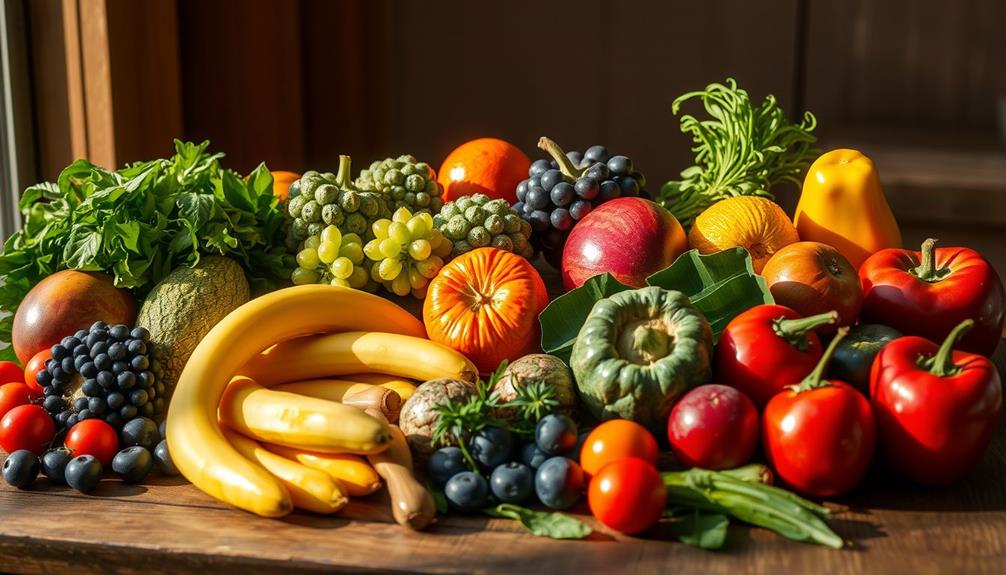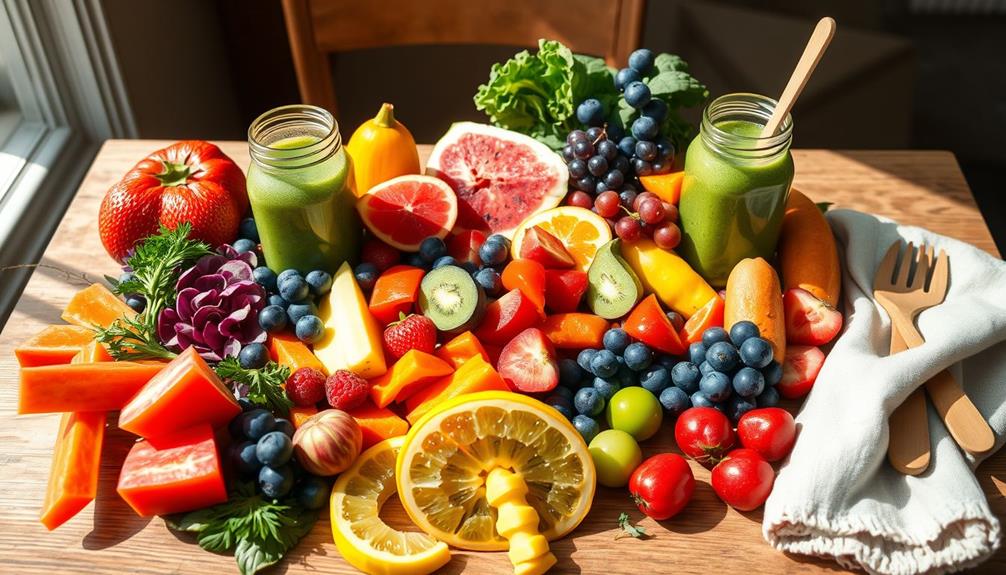You can eat raw food, but it's important to know the risks involved. Raw diets focus on unprocessed fruits, vegetables, nuts, and seeds, which can boost your nutrient intake and aid digestion. However, you may face nutritional deficiencies, especially in protein and vitamins like B12 and iron. Food safety is also a concern, as raw animal products can harbor harmful bacteria. To stay safe, wash your produce well and avoid high-risk foods. Balancing raw meals with cooked options might enhance your overall nutrition. Discovering more about safe practices and meal ideas could help your journey toward a raw food diet. Bringing raw food on a plane can also present challenges, as some items may not be allowed through security or might spoil during the journey. It’s important to research the regulations and guidelines for bringing food on a plane, and consider packing non-perishable options or pre-cooked meals for travel. With careful planning and consideration, incorporating raw foods into your diet can be a healthy and rewarding choice.
Key Takeaways
- A raw food diet consists of unprocessed fruits, vegetables, nuts, seeds, and sprouted grains, typically not heated above 104-118°F (40-48°C).
- While raw foods are nutrient-rich and high in antioxidants, they may lead to deficiencies in vitamin B12, iron, and protein.
- Raw animal products carry risks of bacterial contamination and should be avoided, especially by vulnerable groups like pregnant women and children.
- Safe practices include thoroughly washing produce, avoiding cross-contamination, and being mindful of foodborne illness risks associated with raw foods.
- Transitioning to a raw food diet should be gradual, incorporating simple recipes and maintaining food safety to support digestive adjustment.
Understanding Raw Food Diets
When diving into raw food diets, you'll find that they focus on eating unprocessed, whole foods to maximize nutrient intake. These diets primarily consist of raw fruits, vegetables, nuts, seeds, and sprouted grains, with the temperature never exceeding 104-118°F (40-48°C). This approach aims to preserve the nutritional value and enzymes that can be lost through cooking.
Additionally, many raw foods, such as celery juice, are rich in antioxidants and can provide anti-inflammatory benefits, complementing the raw food philosophy high levels of antioxidants.
You'll encounter various types of raw food diets, including the raw vegan diet, which excludes all animal products, and other variations that may include raw dairy or even raw meats. While the appeal often lies in the health benefits, you need to be aware of potential nutritional deficiencies, particularly in protein, vitamin B12, iron, and omega-3 fatty acids. Careful planning and supplementation may be necessary to meet your nutritional needs.
Food safety is another vital aspect; raw foods can harbor harmful bacteria, which can lead to foodborne illnesses. Certain raw foods, like kidney beans and rhubarb leaves, can be toxic if not prepared properly.
Health Benefits of Raw Foods

Raw foods offer an array of health benefits that can greatly enhance your well-being. By incorporating more raw fruits and vegetables into your diet, you're likely to boost your intake of essential vitamins and dietary fiber, which can improve digestion and promote regular bowel movements. These nutrient-dense foods are rich in antioxidants, helping to lower the risk of chronic diseases like heart disease and certain cancers.
Additionally, raw foods can aid in weight loss since they tend to be lower in calories and higher in water content, promoting a feeling of fullness. The natural enzymes found in raw foods may also enhance digestion, making nutrient absorption more efficient than with cooked foods. By focusing on a plant-based diet rich in raw foods, you'll likely reduce your consumption of processed items, leading to lower intake of added sugars, unhealthy fats, and sodium.
Here's a quick overview of the benefits:
| Benefit | Description | Impact on Health |
|---|---|---|
| Vitamins | High in essential vitamins | Boosts immune system |
| Antioxidants | Fights free radicals | Reduces disease risk |
| Dietary Fiber | Aids digestion | Promotes regularity |
| Weight Loss | Low in calories, high in water | Encourages satiety |
| Natural Enzymes | Supports digestion | Improves nutrient absorption |
Nutritional Risks and Concerns

Maneuvering a raw food diet can pose several nutritional risks and concerns that you should be aware of. A strict raw diet often leads to nutrient deficiencies, especially in essential nutrients like vitamin B12, iron, calcium, and omega-3 fatty acids, which are less bioavailable in plant sources.
Cooking certain foods, like tomatoes, can enhance the absorption of beneficial compounds, meaning you might miss out on crucial nutrients when consuming them raw. Additionally, incorporating foods with glycolic acid benefits can be advantageous for overall health, as they promote skin clarity and may help improve nutrient absorption.
Moreover, a raw vegan diet typically lacks sufficient protein and iron, making supplementation necessary to meet your nutritional needs. You should also consider the increased risk of foodborne illnesses associated with raw animal products and certain raw vegetables, as they can harbor harmful bacteria and toxins.
Furthermore, shifting to a raw food diet may lead to digestive issues such as gas and cramping. This discomfort often arises from the high fiber content and anti-nutrients present in some raw foods, which can hinder nutrient absorption.
Being mindful of these nutritional risks and concerns will help you make informed choices and maintain a balanced, healthy diet.
Safe Raw Food Practices

When you're preparing raw food, always wash your fruits and vegetables thoroughly under running water to get rid of harmful bacteria.
It's also essential to cook animal products to the right internal temperatures to guarantee safety and eliminate any potential pathogens.
Additionally, consider the benefits of cold medications overview for managing any symptoms that may arise from consuming raw foods.
Washing Produce Thoroughly
Making sure your fruits and vegetables are clean is essential for safe raw food practices. Always wash produce under running water to effectively remove dirt, bacteria, and pesticide residues before you eat. Regularly cleaning your food can help prevent contamination, similar to how air purifier maintenance enhances indoor air quality.
You'll want to scrub thicker-skinned items, like potatoes and cucumbers, with a clean brush or cloth to further reduce contamination risks.
Avoid using soap, bleach, or other chemical cleaners, as they can leave harmful residues on your food. Instead, opt for a simple rinse. It's best to wash produce immediately before use rather than before storage. This approach minimizes bacterial growth during storage, keeping your food safer for longer.
For leafy greens, consider soaking them in a bowl of water, gently swishing them around, and then rinsing them under running water. This method makes sure thorough cleaning and removes any stubborn dirt or bacteria hiding in the leaves.
Cooking Animal Products Safely
While washing produce is vital for keeping your meals safe, cooking animal products properly is equally important to prevent foodborne illnesses. To guarantee safety, always cook meat to an internal temperature of 160°F, poultry to 165°F, fish to 145°F, and egg dishes to 160°F. This helps eliminate harmful bacteria that can cause serious health issues.
Additionally, incorporating certain essential oils, such as eucalyptus oil for its antiseptic qualities, can assist in maintaining overall health and hygiene in your kitchen.
Raw eggs are particularly risky; you should always cook them until both the white and yolk are firm to prevent salmonella contamination. It's also essential to avoid cross-contamination in your kitchen. Use separate cutting boards for raw meat and other foods to minimize the risk of spreading bacteria.
If you enjoy seafood, remember that oysters and raw fish can harbor viruses and bacteria. Thorough cooking is necessary to prevent illnesses like vibriosis and hepatitis A.
Lastly, maintain proper kitchen hygiene. Always wash your hands after handling raw animal products to reduce the chances of foodborne illness. By following these guidelines, you can enjoy your meals while keeping your health in check.
Raw Animal Products Dangers

When you consume raw animal products, you're putting yourself at risk for serious bacterial contamination. Pathogens like Salmonella and E. coli can thrive in undercooked seafood, meat, and eggs, leading to potential health issues.
It's also important to be aware that certain foods, including those related to mammography guidelines, can influence overall health and screening practices.
To stay safe, it's essential to follow proper cooking guidelines and guarantee all animal products are cooked to the right temperatures.
Bacterial Contamination Risks
Raw animal products, such as sushi, ceviche, and oysters, can expose you to serious bacterial contamination risks. These foods often harbor harmful pathogens like Salmonella and E. coli, which can lead to severe foodborne illnesses.
If you enjoy raw seafood, be aware that it can result in infections such as vibriosis and hepatitis A, especially if the seafood comes from contaminated waters. Proper hygiene and aftercare are essential not only for piercings but also to minimize the risk of contamination when handling raw foods, as mentioned in piercing care and hygiene.
Consuming raw or undercooked pork also poses significant dangers, as it can carry bacteria like Salmonella and listeria. To stay safe, pork should always be cooked to a minimum internal temperature of 145°F.
Additionally, raw eggs can contain Salmonella bacteria, so it's best to cook them until both the white and yolk are firm.
High-risk groups, including pregnant women, children, and individuals with weakened immune systems, should avoid consuming these raw animal products altogether. The risk of food poisoning is simply too high, and taking precautions is essential for your health.
Cooking Safety Guidelines
Understanding the risks associated with raw animal products is essential for guaranteeing your safety in the kitchen. Raw animal items like sushi, ceviche, and raw oysters can harbor harmful bacteria and viruses, leading to foodborne illnesses.
For instance, raw eggs often contain Salmonella, so it's important to cook them until both the white and yolk are firm. Individuals with certain conditions, such as BPD symptoms, may be more susceptible to the impacts of foodborne illnesses due to emotional dysregulation and impulsivity in decision-making.
When preparing pork, remember that it must reach a minimum internal temperature of 145°F and rest for at least three minutes to eliminate dangerous pathogens like Salmonella and listeria. Raw oysters should always be cooked thoroughly to avoid viruses, including Vibrio, which can cause severe illness.
Additionally, don't overlook uncooked dough—raw flour can contain E. coli, making it unsafe for consumption.
Following these cooking safety guidelines helps you minimize the risks associated with raw animal products and guarantees a safer culinary experience. Always prioritize cooking your food properly to protect yourself from potential health hazards.
Adhering to these safety measures is essential for enjoying the benefits of raw food without compromising your well-being.
Food Preparation Techniques

Food preparation techniques play an essential role in maximizing the nutritional benefits of raw ingredients. By employing methods like soaking beans and grains in water, you can enhance digestibility and reduce anti-nutritional factors present in raw foods. This simple step makes your meals not only healthier but also easier for your body to absorb.
Additionally, these techniques can support digestive health, as the high fiber content in raw foods aids in proper digestion and nutrient absorption promotes digestive health.
Sprouting seeds and grains is another effective technique. It boosts their nutritional value, making them more digestible and nutritious. Plus, it adds a delightful crunch to your dishes.
Dehydrating fruits and vegetables preserves their nutrients while enhancing flavor and extending shelf life, giving you a tasty option for snacks or meal additions.
Juicing fruits and vegetables allows you to enjoy a concentrated intake of vitamins and minerals. This method makes it easier for your body to absorb nutrients, particularly if you're looking for a quick and invigorating way to boost your health.
Just remember, it's important to avoid heating raw foods above 104-118°F (40-48°C) to maintain their natural enzymes and nutritional properties.
Sample Raw Food Menu

Creating a week-long sample menu can help you seamlessly integrate raw foods into your diet. Start your mornings with invigorating smoothies made from seasonal produce, like spinach and bananas, to fuel your day.
Incorporating a variety of fruits and vegetables can enhance your overall health, as seen in lifestyle for longevity. For lunch, prepare vibrant salads filled with a variety of raw vegetables, nuts, and sprouted grains to enhance nutritional value.
Dinner can be a delightful experience with zucchini noodles topped with a raw tomato sauce.
Consider these snack and dessert options to keep your energy up:
- Fresh fruits like apples or berries
- Raw nut bars for a protein boost
- Raw cacao energy balls for a sweet treat
- Fruit sorbet made from blended frozen fruits
Tips for Transitioning

Changing to a raw food diet can be an exciting journey toward better health and energy. Start by incorporating small amounts of raw foods into your meals, like adding fresh fruits and vegetables, to gradually adjust your palate and digestive system.
Experiment with simple recipes, such as smoothies or salads, focusing on seasonal produce for better flavor and nutrition. This approach makes the change enjoyable and less overwhelming.
Investing in kitchen tools like a high-quality blender or food processor can greatly enhance your meal preparation and allow for a wider variety of raw dishes.
To stay motivated, join online communities or local groups centered around raw food diets. These spaces provide support, recipe sharing, and encouragement throughout your change.
As you make changes, don't forget about food safety practices. Wash all produce thoroughly and be aware of which raw foods may pose health risks.
Following these change tips will help you smoothly shift to a raw food diet while ensuring your journey is safe and delicious. Embrace the process, and enjoy discovering new flavors and creative ways to incorporate raw foods into your healthy diet!
Research and Trends in Raw Foods

The raw food movement has surged in popularity, driven by a growing awareness of health and wellness among consumers. With millions of social media posts featuring the hashtag #rawfood, it's clear that unprocessed diets are becoming a trend.
However, research suggests a mixed bag of benefits and challenges associated with the raw food diet.
While you can enjoy increased intake of essential vitamins, minerals, and fiber, you might also face nutrient deficiencies, particularly in vitamin B12, iron, and omega-3 fatty acids.
Here are a few key points to reflect on:
- Cooking certain foods can enhance bioavailability, making nutrients more accessible.
- The raw food diet aligns with broader health trends like plant-based eating and clean eating.
- Practical challenges include time-consuming meal prep and the potentially higher cost of ingredients.
- Balancing raw foods with cooked options may be beneficial for peak nutrition.
As you explore the raw food diet, weigh both its advantages and potential drawbacks to create a sustainable and healthy eating plan that works for you.
Frequently Asked Questions
What Are the Rules for Raw Food?
When following raw food rules, focus on unprocessed, whole foods and avoid cooking. Embrace methods like juicing or sprouting, guarantee proper food safety, and watch for potential nutrient deficiencies to maintain balanced nutrition.
How Can You Eat Raw Food Safely?
To indulge in raw delights safely, you should wash all produce thoroughly, source animal products from trusted suppliers, and maintain impeccable kitchen hygiene. Always educate yourself on potential risks and proper preparation techniques to savor without worry.
Is It OK to Eat Raw Foods?
It's okay to eat raw foods, but make certain you wash them thoroughly to reduce risks. Be cautious with high-risk items, and consider your nutritional needs, as a strictly raw diet can lead to deficiencies.
What Are the Risks of a Raw Food Diet?
Imagine dining on a plate of bacteria-infested veggies and toxin-laden beans! A raw food diet can lead to foodborne illnesses, nutritional deficiencies, and digestive woes. You've gotta plan wisely to avoid these risks!
Conclusion
Incorporating raw foods into your diet can be a vibrant way to boost your health, but it comes with its own set of risks. While the crunch of fresh veggies and the zing of zesty fruits can invigorate your meals, remember that safety is key. Balancing the allure of raw eating with cautious practices guarantees you reap the benefits without compromising your well-being. So, embrace the freshness, but stay informed and prepared for a successful journey!










